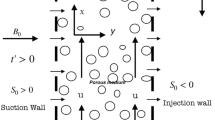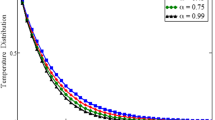Abstract
In this work, a recent residual distribution scheme and a second-order finite volume method are compared to model the transport of a pollutant in free surface flows. The phenomenon is described in two dimensions using the shallow water (SW) system augmented by a scalar conservation law for the pollutant transport. The two numerical methods are developed to minimize the numerical diffusion which is a critical problem for transport phenomena. The conservation of the mass and the monotonicity of the solution are two other important numerical requirements necessary to reproduce the physics of the problem. These three features (low numerical diffusion—mass conservation—monotonicity) will be theoretically analyzed and then numerically verified through a series of test cases. Both methods are used on completely unstructured grids, but the regularity of the grid with respect to the streamlines direction produces for the two methods different behaviours which will be studied. This work has been realized within the Telemac-2D system, constituted by a finite element kernel and a finite volume kernel. Telemac2D uses several numerical schemes, including the new schemes presented here. The aim of this paper is to present state-of-the-art research in the field of finite volumes (FV) and of residual distribution schemes for advection problems.













Similar content being viewed by others
References
Abgrall R, Mezine M (2003) Construction of second order accurate monotone and stable residual distribution schemes for unsteady flow problems. J Comp Phys 188(1):16–55. doi:10.1016/S0021-9991(03)00084-6
Ata R, Pavan S, Khelladi S, Toro EF (2013) A weighted average flux (WAF) scheme applied to shallow water equations for real-life applications. Adv Water Resour 62:155–172. doi:10.1016/j.advwatres.2013.09.019
Audusse E, Bristeau MO (2003) Transport of pollutant in shallow water a two time steps kinetic method. ESAIM Math Model Numer Anal 37(2):389–416. doi:10.1051/m2an:2003034
Audusse E, Bristeau MO (2005) A well-balanced positivity preserving second-order scheme for shallow water flows on unstructured meshes. J Comput Phys 206(1):311–333. doi:10.1016/j.jcp.2004.12.016
Audusse E, Bouchut F, Bristeau MO, Klein R, Perthame B (2004) A fast and stable well-balanced scheme with hydrostatic reconstruction for shallow water flows. SIAM J Sci Comput 25(6):2050–2065. doi:10.1137/S1064827503431090
Batten P, Clarke N, Lambert C, Causon D (1997) On the choice of wavespeeds for the HLLC Riemann solver. SIAM J Sci Comput 18(6):1553–1570. doi:10.1137/S1064827593260140
Benkhaldoun F, Elmahi I, Seaïd M (2007) Well-balanced finite volume schemes for pollutant transport by shallow water equations on unstructured meshes. J Comput Phys 226(1):180–203. doi:10.1016/j.jcp.2007.04.005
Benque JP, Labadie G, Ronat J (1982) Une méthode d’éléments finis pour la résolution des équations de Navier–Stokes couplées à une équation thermique. In: Proceedings of 4th international symposium on finite element methods for fluid mechanics problems, Tokyo
Bouchut F (2004) Nonlinear stability of finite volume methods for hyperbolic conservation laws. Frontiers in Mathematics. Birkhuser, Basel. doi:10.1007/b93802
Deconinck H, Ricchiuto M (2007) Residual distribution schemes: foundations and analysis. In: Stein E, de Borst R, Hughes TJR (eds) Encyclopedia of computational mechanics. Johy Wiley and Sons Ltd, Chichester. doi:10.1002/0470091355.ecm054
Dervieux A, Vijayasundaram G (1985) Numerical methods for the Euler equations for fluid dynamics. Chapter: On numerical schemes for solving Euler equations of fluid dynamics.SIAM, pp 121–144
Diskin B, Thomas JL (2011) Comparison of node-centered and cell-centered unstructured finite-volume discretizations: inviscid fluxes. AIAA J 49(4):836–854. doi:10.2514/1.J050897
Fernández-Nieto ED, Bresch D, Monnier J (2008) A consistent intermediate wave speed for a well-balanced HLLC solver. Comp Rend Math 346(13–14):795–800. doi:10.1016/j.crma.2008.05.012
Gross ES, Koseff JR, Monismith SG (1999) Evaluation of advective schemes for estuarine salinity simulations. J Hydraul Eng 125(1):32–46. doi:10.1061/(ASCE)0733-9429(1999)125:1(32)
Guinot V, Delenne C (2012) MUSCL schemes for the shallow water sensitivity equations with passive scalar transport. Comput Fluids 59:11–30. doi:10.1016/j.compfluid.2012.02.001
Hervouet JM (1986) Computational techniques for fluid flow. Chapter: Application of the method of characteristics in their weak formulation to solving two-dimensional advection equations on mesh grids. Pineridge Press, Swansea
Hervouet JM (2007) Hydrodynamics of free surface flows. John Wiley and Sons Ltd, Chichester. doi:10.1002/9780470319628
Hervouet JM (2013) The weak form of the method of characteristics, an amazing advection scheme. In: Proceedings of XXth TELEMAC-MASCARET user conference 2013. 16–18 Oct 2013, Karlsruhe
Hou J, Liang Q, Simons F, Hinkelmann R (2013) A 2d well-balanced shallow flow model for unstructured grids with novel slope source term treatment. Adv Water Res 52:107–131. doi:10.1016/j.advwatres.2012.08.003
Hou J, Liang Q, Zhang H, Hinkelmann R (2014) Multislope MUSCL method applied to solve shallow water equations. Comput Math App 68(12):2012–2027. doi:10.1016/j.camwa.2014.09.018
Kolgan NE (1972) Application of the minimum-derivative principle in the construction of finite-difference schemes for numerical analysis of discontinuous solutions in gas dynamics. Uchenye Zapiski TsaGI Sci Notes Central Inst Aerodyn 3(6):68–77
Li S, Duffy CJ (2012) Fully-coupled modeling of shallow water flow and pollutant transport on unstructured grids. Procedia Environ Sci 13:2098–2121. doi:10.1016/j.proenv.2012.01.200
Liang Q, Borthwick AGL (2009) Adaptive quadtree simulation of shallow flows with wetdry fronts over complex topography. Comput Fluids 38(2):221–234. doi:10.1016/j.compfluid.2008.02.008
Mesaros LM (1995) Multi-dimensional fluctuations splitting schemes for the Euler equations on unstructured grids. PhD thesis, University of Michigan
Murillo J, Garca-Navarro P (2012) Augmented versions of the HLL and HLLC Riemann solvers including source terms in one and two dimensions for shallow flow applications. J Comput Phys 231(20):6861–6906. doi:10.1016/j.jcp.2012.06.031
Perthame B, Qiu Y (1994) A variant of Van Leer method for multidimensional system of conservation laws. J Comput Phys 112(2):370–381
Postma L, Hervouet JM (2007) Compatibility between finite volumes and finite elements using solutions of shallow water equations for substance transport. Int J Numer Methods Fluids 53(9):1495–1507. doi:10.1002/fld.1373
Ricchiuto M (2005) Construction and analysis of compact residual discretizations for conservation laws on unstructured meshes. PhD thesis, Universite Libre de Bruxelles and von Karman Institute for Fluid Dynamics
Ricchiuto M (2013) An explicit residual based approach for shallow water flows. http://hal.archives-ouvertes.fr/hal-00855645/
Ricchiuto M (2015) An explicit residual based approach for shallow water flows. J Comput Phy 280:306–344. doi:10.1016/j.jcp.2014.09.027
Ricchiuto M, Abgrall R (2010) Explicit RungeKutta residual distribution schemes for time dependent problems: second order case. J Comput Phys 229(16):5653–5691. doi:10.1016/j.jcp.2010.04.002
Ricchiuto M, Bollermann A (2009) Stabilized residual distribution for shallow water simulations. J Comput Phys 228(4):1071–1115
Ricchiuto M, Abgrall R, Deconinck H (2007) Application of conservative residual distribution schemes to the solution of the shallow water equations on unstructured meshes. J Comput Phys 222(1):287–331. doi:10.1016/j.jcp.2006.06.024
Roe PL (1987) Linear advection schemes on triangular meshes. Technical report coa 8720, Cranfield Institute of Technology
Russell TF, Celia MA (2002) An overview of research on Eulerian Lagrangian localized adjoint methods (ELLAM). Adv Water Resour 25(8–12):1215–1231. doi:10.1016/S0309-1708(02)00104-5
Sidilkover D, Roe PL (1995) Unification of some advection schemes in two dimensions. Technical report, DTIC document
Song L, Zhou J, Guo J, Zou Q, Liu Y (2011) A robust well-balanced finite volume model for shallow water flows with wetting and drying over irregular terrain. Adv Water Resour 34(7):915–932. doi:10.1016/j.advwatres.2011.04.017
Song L, Zhou J, Li Q, Yang X, Zhang Y (2011) An unstructured finite volume model for dam-break floods with wet/dry fronts over complex topography. Int J Numer Methods Fluids 67(8):960–980. doi:10.1002/fld.2397
Stoker JJ (1992) Water waves: the mathematical theory with applications. John Wiley and Sons Inc., Hoboken. doi:10.1002/9781118033159
Struijs R (1994) A multi-dimensional upwind discretization method for the Euler Equations on unstructured grids. PhD thesis, University of Delft, Netherlands
Toro EF (2001) Shock capturing methods for free-surface shallow flows
Toro EF (2009) Riemann solvers and numerical methods for fluid dynamics. Springer, Berlin. doi:10.1007/b79761
Van Leer B (1979) Towards the ultimate conservative difference scheme. V. A second-order sequel to Godunov’s method. J Comput Phys 32(1):101–136. doi:10.1016/0021-9991(79)90145-1
Acknowledgments
This work was partly funded by the French Research Agency (CIFRE agreement #2012-1654). The authors thank Mario Ricchiuto for helpful discussions and kind support.
Author information
Authors and Affiliations
Corresponding author
Rights and permissions
About this article
Cite this article
Pavan, S., Ata, R. & Hervouet, JM. Finite volume schemes and residual distribution schemes for pollutant transport on unstructured grids. Environ Earth Sci 74, 7337–7356 (2015). https://doi.org/10.1007/s12665-015-4760-5
Received:
Accepted:
Published:
Issue Date:
DOI: https://doi.org/10.1007/s12665-015-4760-5




